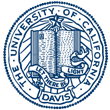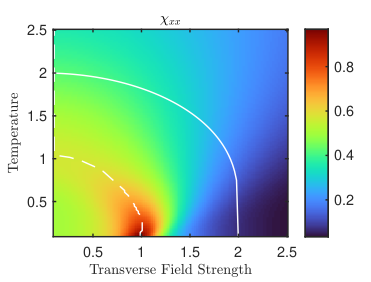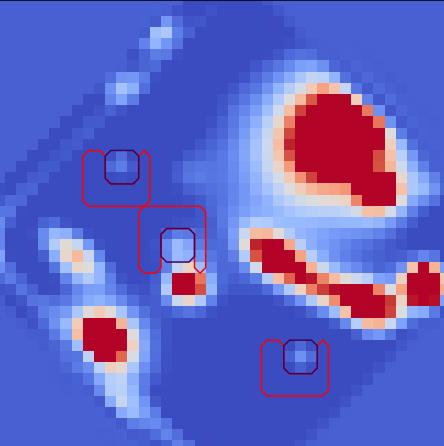
This REU program was funded through NSF PHY-2150515.

Heat map of transverse susceptibility, from Kaeshav Danesh's paper.
Students' names link to their final papers. Advisors' names link to the research group web pages.
Condensed Matter Theory
Bianca Pol (University of Chicago) and Matthew Nelson (Kalamazoo College) worked with Richard Scalettar) on the Blume-Capel model, a two-dimensional triangular lattice of spins that experience both a nearest neighbor interaction and a chemical potential. If the spin-spin interaction is antiferromagnetic, favoring alignment of neighbors in opposite directions, the triangular lattice geometry can frustrate long-range order; it is not possible to have all nearest neighbor pairs in opposite directions. Matthew introduced a chemical potential and worked in the grand canonical ensemble, computing various thermodynamic quantities to study how the phase diagram evolved. He found unusual features in specific heat suggesting that the system may have separate charge and spin ordering tempartures. Bianca studied the charge ordering side, performing numerical simulations to study the phase diagram as a function of both the Ising interaction and the chemical potential. The chemical potential changes the number of occupied sites, and she found that for some occupation numbers the vacant sites formed regular patterns -- hence the system had "charge order."
Kaeshav Danesh (Harvey Mudd College; advisor Rajiv Singh) studied the transverse susceptibility in the transverse field Ising model. In this model, spins align along the z axis, but a DC magnetic field in the x direction (hence "transverse field") destabilizes magnetic order. Eventually the field drives the system to a quantum critical point, where the ground state changes from ferromagnetic to paramagnetic. The model is useful for investigating quantum critical fluctuations near a quantum critical point. Most previous theoretical studies focused on how the longitudinal susceptibility (parallel to z) diverges, and less was known about transverse susceptibility. Mean field theory predicts it should not diverge, but by using exact diagonalization of finite sized lattices, Kaeshav found that the transverse susceptibility does appear to diverge at the quantum critical point.
Condensed Matter Experiment


Caleb Williams (Macalester College; advisor Nicholas Curro) worked on developing and testing a novel method for measuring the strain response of crystals with nuclear magnetic resonance (NMR). The NMR properties of nuclei in solids depend on the presence of strain fields, and can be measured directly by applying static forces to a crystal and measuring the NMR response. On the other hand, an NMR spin echo experiment enables one to measure the response to pulsed strain fields and extract the same information. This new approach is several orders of magnitude more sensitive, and will enable studies of crystals that previously have been inaccessible. The graph above shows the applied voltage (proportional to the strain) as a function of time, along with part of the signal.
Astrophysics
Erin Coleman (Gustavus Adolphus College; advisor Tucker Jones) studied the flow of interstellar gas surrounding a distant galaxy that was observed with the Keck telescope recently. A particular feature of this galaxy is that its light is magnified by gravitational lensing, which enables researchers to study its spectral signatures in detail. Erin was able to fit various features of the emission spectra to determine the velocity of the gas both flowing into and out of the main galaxy. The three regions outlined in black in the image below indicate the objects Erin was analyzing, with the larger red boxes showing the regions used to identify background signals. The elongated red object is evidence of gravitational lensing, where the bending of light on its path to us makes the object appear greatly expanded in one direction.

Particle Theory
Joey Takach (Oregon State University; advisor Markus Luty) investigated the feasibility of a truncation approach in studying field theory. Although field theory has been very successful for weak coupling problems, it can be extremely difficult to calculate field theories for strong coupling problems, such as in quantum chromodynamics. Various approaches have been proposed as approximations, and one potential avenue is simply to work with only a subset of Hilbert space corresponding to low energies. Joey performed numerical simulations on a one-timensional lattice to evaluate the effectiveness of a truncation technique.
Particle Experiment
Noe Gonzalez (University of California Santa Cruz; advisor Matthew Citron ) characterized key instrumentation for use in the upcoming milliQan detector at the Large Hadron Collider (LHC). One of the intriguing aspects of certain theories of dark matter is that dark matter particles may exhibit very small charges, many times smaller than the charge on an electron. If such particles were created in the high energy collisions at the LHC, then they could easily be missed by the current detectors. A new type of detector is thus being developed, consisting of state-of-the-art scintillators located off the main axis of the collider. Noe worked to test and characterize some of these components before they are installed.
Nuclear Experiment

Eden Thompson (University of Wisconsin) and Dylan Delgado (Lawrence College) worked with advisors Daniel Cebra and Manuel Calderon de la Barca Sanchez to simulate the interactions between various nuclei at high energies. The ultimate goal was better understanding the effect of galactic cosmic rays on spacecraft. NASA is particularly interested in nuclear cross-sections of silicon and iron, common materials in spacecraft, and there are plans to perform measurements at the Relativistic Heavy Ion Collider at Brookhaven National Laboratory. Eden and Dylan did calculations on whether the cross-sections of aluminum and nickel would be similar, since these materials are easier to arrange experiments on. They used the Glauber model to model the nucleon distribution within these nuclei, then calculated the expected difference in the cross sections. The results suggest that data on the substituted materials will indeed give adequate information. The illustration above gives the idea of a Glauber model: two nuclei (pink and blue), traveling parallel to the horizontal axis but in opposite directions, collide. The nuclei are about 5 fm off-center (vertical displacement), and only some of their nucleons (the darker colors) actually interact during the collision. Eden and Dylan worked on how much a slight change in the total number of nucleons would affect the number that interact.